Veni is a simple, multi-purpose theme – if you need a theme that combines a blog, portfolio, and simple shop for selling trinkets – this theme is a perfect choice for you.
Learn how you can get the most out of the theme with the Veni WordPress theme documentation.
Veni WordPress theme documentation, step 1: Theme specifications
- Recommended logo size 220x50px.
- The featured image width should be 1200px.
- Single post and page content width should be 760px.
Veni WordPress theme documentation, step 2: Theme installation
The theme can be installed through the WordPress Admin panel.
- Log in to the WordPress Admin panel.
- Go to Appearance -> Themes.
- Click on the Add New button, at the top of the screen.
- In Add Themes screen, click on Upload Theme.
- Click on Choose theme, and then browse for theme file on your computer.
- Click on Install Now to start the install process.
- After the installation is done, click on Activate theme.
A detailed video for theme installation is available here: https://help.themeskingdom.com/how-to-install-and-setup-the-theme.
After activating the theme, you will be prompted to install the required plugins. Required plugins in the Veni WordPress theme documentation are:
Veni WordPress theme documentation, step 3: Theme demo
To set the theme as presented in our demo, you can import the demo file.
NOTE: Before importing the demo content from the file, make sure to connect Jetpack plugin, and activate Portfolio post type under Jetpack -> Settings -> Writing.
Veni WordPress theme documentation, step 4: Theme setup
Veni theme is set to display the latest posts on the homepage. To set your theme the same way we did in our demo, you’ll need to:
- First, you will need to create several post categories. Categories will be used to group posts, and in the theme, we will use them in the navigation and set Featured Category Slider.
- When you are done with creating the categories, create several posts and associate them with different categories. Make sure to set the featured image for each post. Tag desired posts with the same tag (e.g., “Featured”). We will use this tag to display those posts in the featured content slider which is displayed on the top of the homepage.
- Create several portfolio items, as well. Be sure to set the featured images for each portfolio item.
- Now, you’ll need to create pages where your content will be displayed – create pages About Me, Contact, and Photo Stories. About Me and Contact, pages are using the Default page template, while Photo Stories is using the Portfolio page template. Insert a contact form into the Contact page. Pages like Shop, Cart, Checkout and My Account are created by the WooCommerce plugin.
- For pages About Me, Photo Stories, and Contact set featured image and add Excerpt. This step is needed in order to display them on the homepage as featured pages.
- Veni theme is using Your latest post-reading settings, so you don’t need to change it.
- Go to Appearance -> Menus and create a new menu. Add Home as Custom Link to your homepage, and add links to Photo Stories, About Me, and Contact pages. Mark this menu as Primary.
- Create another menu – Social menu. Add links to your social profiles using Custom Link. When you are done, mark this menu as Social.
- Finally, you’ll need to tweak a few things in the Customizer. Go to Appearance -> Customize:
- Site Identity: Set a logo and favicon for your site.
- Theme Settings -> Blog Layout Settings you will need to enter the desired text that will appear on the left side of the blog posts page. Set Blog layout to Masonry.
- Theme Settings -> Blog Layout Settings select featured pages from the dropdown. You don’t need to set all three pages. Make sure that the desired pages are set with featured images and excerpts.
- Theme Settings -> Header menu: Select line navigation.
- Theme Settings -> Featured Slider: Enable the Featured-slider, and make it full-width using the Display Featured Slider in full-width option. Select the desired category for the slider. Exclude posts displayed in the slider from the listing. Set the number of posts to be displayed in the slider.
- Theme Settings -> Paging Settings: Set paging settings to Infinite Post Load and set Load type to “On Click”. This feature will not work without the Jetpack plugin.
Veni WordPress theme documentation, step 5: The Customizer

The Customizer in the Veni WordPress theme documentation is a great WordPress feature that allows you to customize the theme and set theme options. Theme-specific settings:
Site Identity
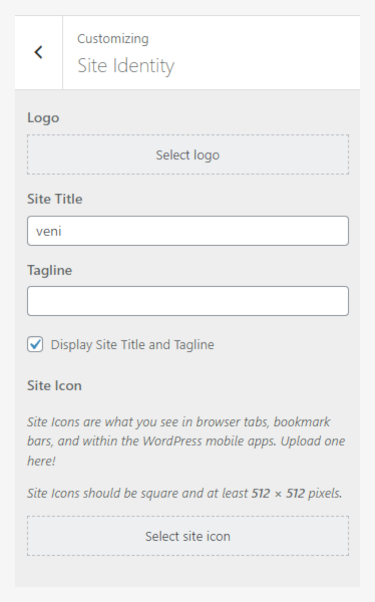
Site Identity allows you to set your site title, tagline, and icon. The Site Title is the name of your site and it’s displayed in the header, where the logo is displayed. The Tagline is a short description or your motto, and it’s displayed just under the title. This setting is the same as in Settings -> General in the WordPress admin panel.
- Logo: Upload logo for your site. The logo should be in a PNG or JPEG/JPG format.
- Site title: Name of your site.
- Tagline: Site punchline.
- Display Site Title and Tagline: If enabled, both Site Title and Tagline will be displayed. The Tagline will be displayed under the title.
- Site Icon: The Site Icon is used as a browser and app icon for your site. Icons must be square, and at least 512px wide and tall.
Menus

This option allows you to manage created menus quickly. You can select which created menu will be displayed as a Primary Menu or Footer Menu. If you need to manage actual menu items, you can do that in Appearance -> Menu.
Widgets
The Widgets section in the Veni WordPress theme documentation allows you to manage widgets in widget areas quickly. This option allows you the same possibility as the Widgets option in the WordPress admin panel.
Homepage Settings
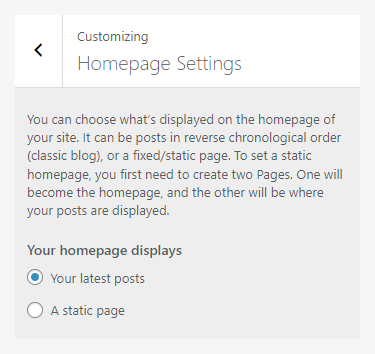
This option works the same way as Settings -> Reading. It allows you to set them to read the latest post or to use static pages for landing and blog pages.
Color Settings
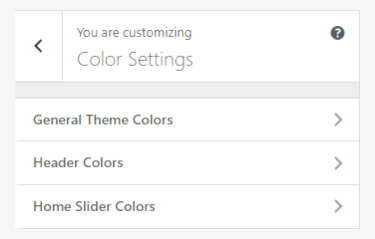
The Colors panel allows you to set the color for different elements of the theme. There are three subpanels:
- General Theme Colors: Color settings for paragraphs, headings, links, link hover color etc…
- Header Colors: Colors used in the header for navigation, slider navigation, and site title.
- Home Slider Colors: Colors used for the Featured Slider, like background color, links, metadata, and such.
Theme Settings
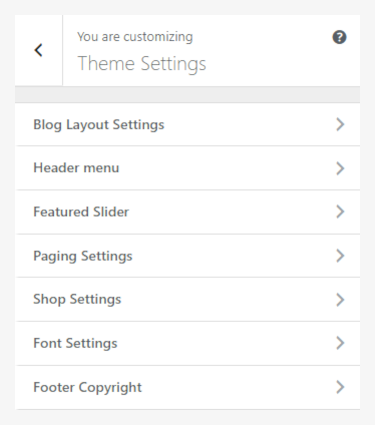
The Theme Options panel in the Veni WordPress theme documentation contains theme-specific settings. Here you can customize the theme appearance – featured slider, Instagram feed, footer, and header settings, and change the layout appearance.
- Blog Layout Settings
- Header Menu
- Featured Slider
- Paging Settings
- Shop Settings
- Font Settings
- Footer Copyright
Blog Layout Settings
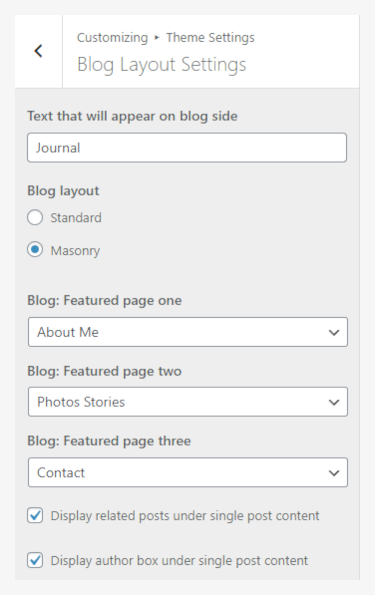
In the Blog Layout Settings panel, you can set the general appearance of the homepage, set featured images, and enable related posts and author box on the single post page.
- Text that will appear on the blog side: When the theme is set to display Latest Posts in Settings -> Reading, this text will appear on the left side of the homepage.
- Blog layout: Veni theme can display posts in two layouts – standard grid and masonry. The number of columns, when the standard grid is set, depends on the screen size, and if the widget sidebar is set.
- Blog featured pages: Featured pages will be displayed under the Featured Slider. Featured Pages must have set featured images and excerpts. If you need to display only one or two pages, leave the remaining dropdowns empty.
- Display related posts under single post content: If this option is checked, related posts will be displayed on the single post page. This feature will only work if the Jetpack plugin is installed and connected.
- Display author box under single post content: If checked, the author box will be displayed under the content.
Header Menu

The header menu panel contains an option for setting the header menu appearance. The standard navigation option will display the menu in the center of the header, with a centered site/logo above it. Line navigation will set the site title/logo and menu inline, where the logo/title is displayed on the left and the menu on the right side.
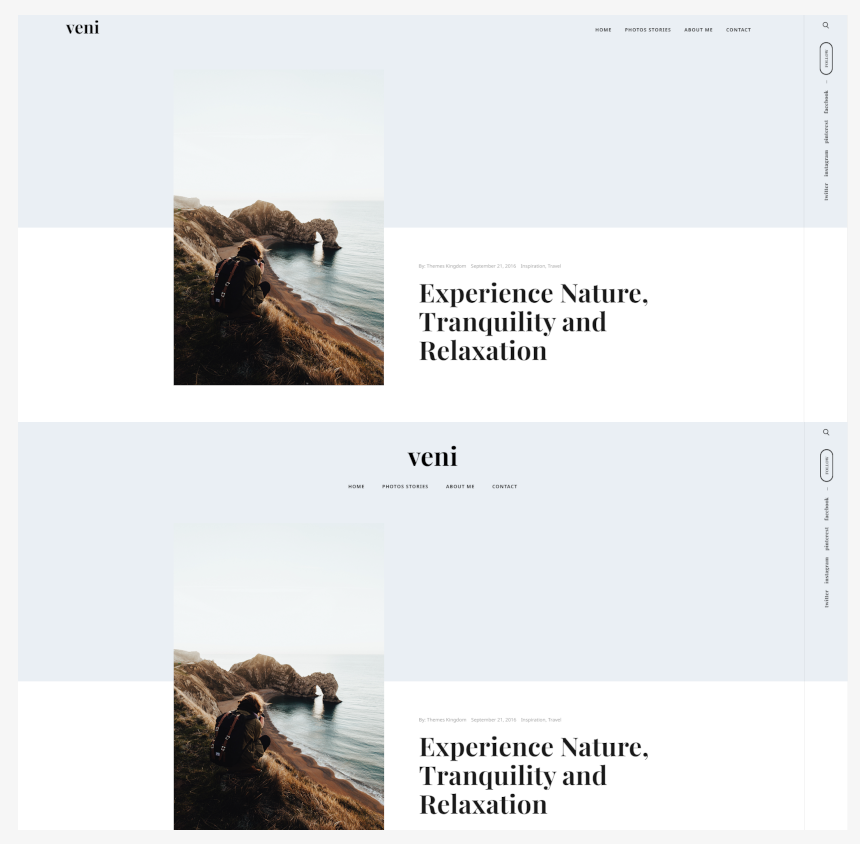
Featured Slider
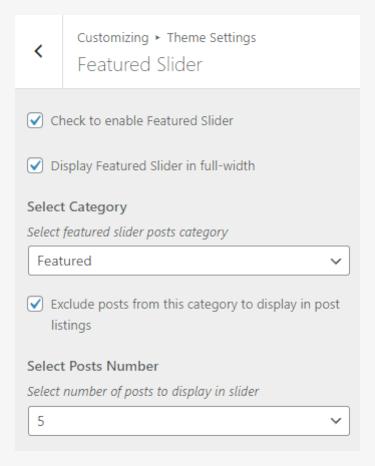
Featured Slider is content that is displayed on the homepage.
- Check to enable Featured Slider: If checked, Featured Slider will be displayed on the homepage.
- Display Featured Slider in full-width: The slider can be displayed in the full-screen mode, or in the boxed mode.
- Select Category: Featured Slider is displaying a featured image from posts. Select the post category that will be displayed in the slider.
- Exclude posts from this category to display in post listings: If checked, posts that are displayed in the slider, will not be displayed in the post listing.
- Select Posts Number: The number of slides can be between 1 and 10.
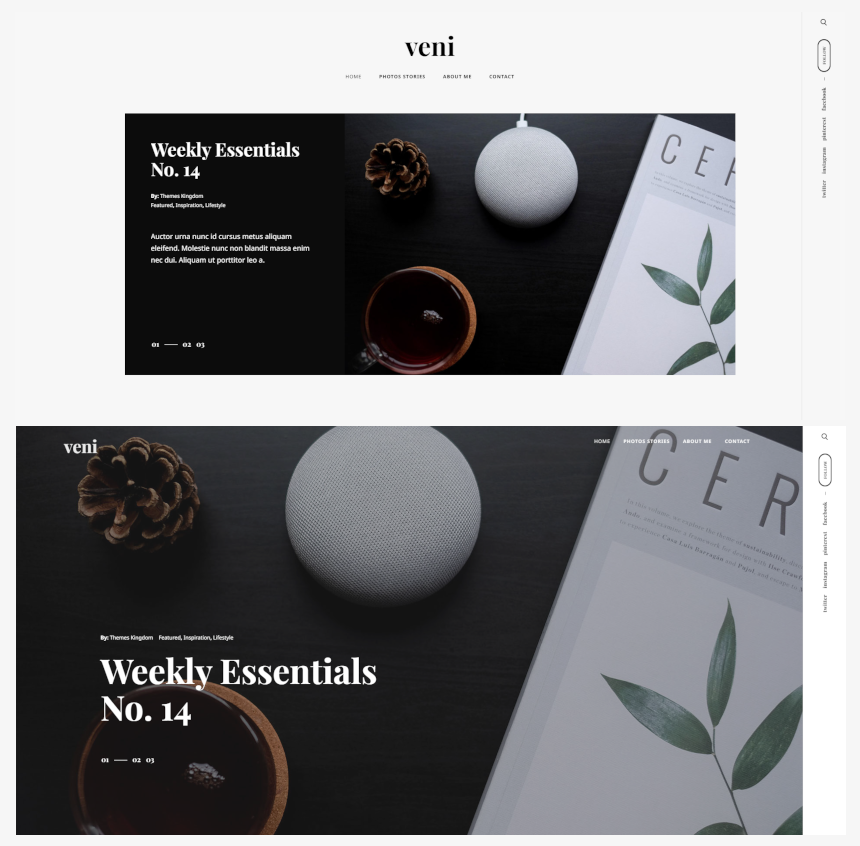
Setting up Featured Content Slider
The Featured Content Slider in the Veni WordPress theme documentation is displayed on the homepage, and setting up the slider is quite simple.
- Make sure that your theme reading settings are set to Your latest post.
- Create several posts and set featured images for each of the posts.
- Group posts in the same category – e.g. “Featured”.
- Go to Appearance -> Customize and in Theme Settings -> Featured Slider panel enable the slider and select the desired post category.
Paging Settings
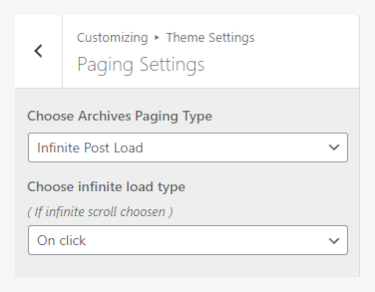
The paging Settings panel controls what type of paging will be used on the site. Paging can be Standard(numerical) or Infinite Post Load. If Infinite Post Load is selected, loading can be On Click or On Scroll. For Infinite Post Load Jetpack plugin must be installed and active.
Shop Settings
There is only one option that allows you to enable a mini cart in the header navigation. This feature will work only if the WooCommerce plugin is installed and active.
Font Settings

In the Font Settings panel can be set font families for paragraphs, headings, and navigation. The font Settings panel is using Google Fonts from the Kirki Framework plugin, so without it will not work.
Footer Copyright
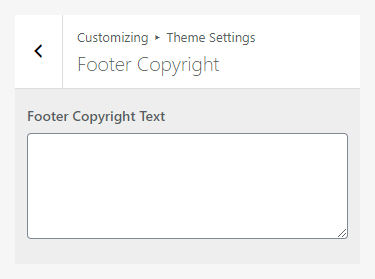
The Footer Copyright panel is used for the copyright text that will be displayed in the footer. You can use simple HTML tags to style the text or create links.
Additional CSS
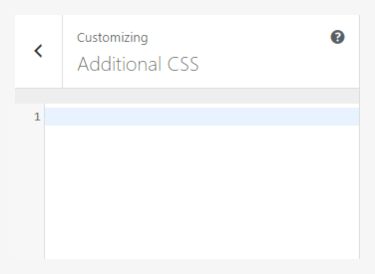
In Additional CSS section can be added CSS classes. This is the safe way to tweak the theme styles, without touching the original CSS file.
Veni WordPress theme documentation, step 6: Theme specific features
Featured Image Size and orientation
The theme detects image orientation, and depending on the image – landscape or portrait orientation and size, the layout of the single post page will vary.
- Landscape: Landscape image will be displayed at the top of the single post page, with the post title under it.
- Portrait: Portrait image and post title will be displayed side by side. Please note that portrait images should not be huge and that you should keep their width under 400px.
Veni WordPress theme documentation, step 7: Useful CSS classes
Increase logo size
.site-branding img{
width: 220px;
}
Remove overlay from featured content slider
..fullwidth-slider .featured-slider .featured-image {
opacity: 1;
}
Hide Footer credits
.site-footer .site-info {
display: none;
}
